Mastering Robot Repair in the Fallout Universe
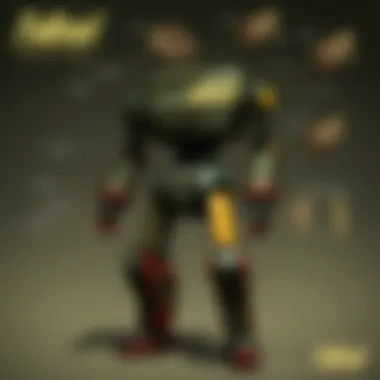
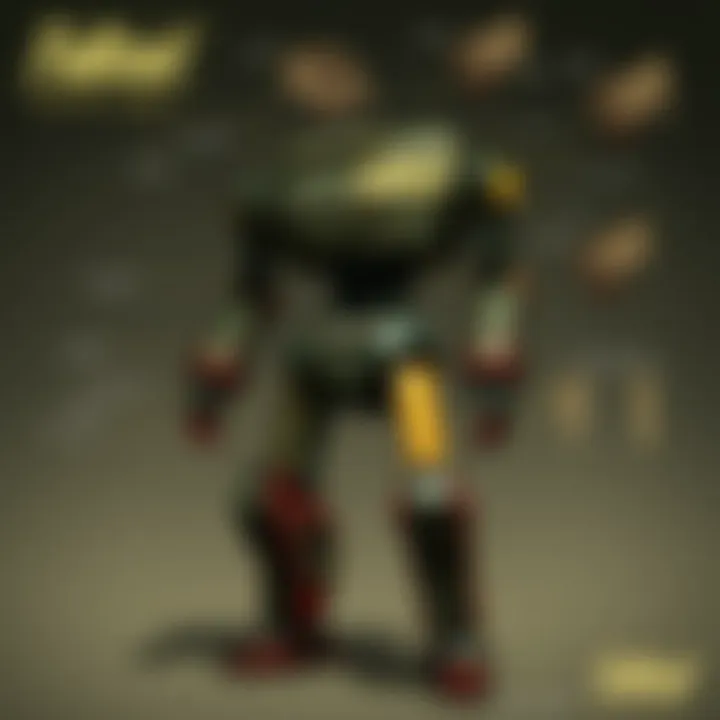
Intro
When stepping into the wasteland of the Fallout universe, players quickly realize that survival hinges not just on conventional weaponry and armor, but also on the mechanics of robotics. Robot repair plays a pivotal role in navigating the treacherous landscape of mutated creatures and hostile factions. The need for efficient robotic companions becomes evident, as these mechanical beings can assist with combat, crafting, and even carrying out mundane tasks. But how does one go about maintaining and optimizing the functions of these machines? This article aims to demystify the intricacies of robot repair, offering insights into the various types of robots, the skills requisite for their upkeep, and the broader implications in the rich lore of the Fallout series.
Lore Insights
Overview of the Fallout Universe
The Fallout universe is a post-apocalyptic world, one shaped by nuclear war and its catastrophic aftermath. Set in an alternate timeline, the series showcases a society where technology advanced rapidly, only to be devastated by humankind's reckless use of it. Robots, a hallmark of this technology, were initially designed for service and support, often becoming sentinels of the pre-war era's corporate and military ambitions. These automatons now hold a mirror to humanity’s follies, creating intriguing stories around their malfunctioning circuits and forgotten commands.
Key Historical Events in the Fallout Timeline
To appreciate the significance of robot repair, it’s useful to walk through some key events that have shaped the Fallout timeline:
- The Great War: The cataclysm that leads to the wasteland we explore. Just two hours of nuclear conflict shattered civilization.
- The Rise of the Brotherhood of Steel: A faction that reveres technology, particularly robotics, gathering remnants of technology for preservation and study.
- The Reclamation of the Wasteland: Various factions, including the Railroad and the Institute, emerge, each with unique perspectives on technology and its use.
These historical moments set the stage not only for player interaction with robots but also for the lore which informs how these mechanical beings can be repaired, upgraded, and understood in their socio-political context.
Deep Dive Into the Backstory of Major Factions and Characters
Certain factions view robots as mere tools, while others, like the Institute, often see them as advanced prototypes with almost human-like qualities. Players must navigate these varying beliefs as they delve into repairs and modifications. Characters such as Paladin Danse and Nick Valentine showcase the spectrum of robotic integration in human society. Danse, being a soldier of the Brotherhood, approaches technology from a militaristic lens, while Valentine serves as a detective, embodying the notion that personality and skill can transcend mere nuts and bolts. Understanding these dynamics offers keen insights into gameplay and the ramifications of one's decisions on robot interactions.
This insight into the Fallout world lays the foundation for understanding the importance of robot repair, not just as a gameplay mechanic, but as a crucial piece of the narrative puzzle.
Prelims to Robot Repair
In the desolate world of the Fallout franchise, robots hold a prominent place, serving varied roles from combat support to simple household tasks. The ability to repair these mechanical companions is not just a skill for survival; it becomes an integral part of understanding the broader narrative woven throughout the series. Repairing robots taps into fundamental gameplay mechanics, linking resource management, strategic planning, and lore appreciation.
The discussion around robot repair reveals layers of complexity behind the creations of pre-war technology, emphasizing how players interact with these constructs within the game. Each successful repair can transform a rusty relic into a dependable ally, reflecting the player's investment in the game’s world. For players navigating the challenges of the wasteland, robot repair equips them with tools to enhance both their combat efficiency and overall survivability.
Moreover, the act of repairing goes beyond mechanics. It engages players with issues of preservation and restoration in a post-apocalyptic setting. Here, robots stand as remnants of a lost era, and by repairing them, players engage in a dialogue about nostalgia and the consequences of technological advancement. Thus, understanding robot repair not only elevates gameplay but also enriches one’s connection to Fallout’s narrative.
Why Robot Repair Matters
- Enhances Gameplay: It improves the effectiveness of robotic companions in battles, making keen repair skills indispensable in high-stakes situations.
- Resource Management: Players develop strategic uses for the materials recovered from the harsh environment, stretching their limited resources and bolstering their tactical options.
- Engagement with Lore: Each repair is framed within the context of Fallout’s rich storytelling, allowing players to delve deeper into the history and purpose of these machines.
Ultimately, the process of robot repair weaves together gameplay elements with narrative depth, offering players a robust experience steeped in both action and thoughtful engagement with the world around them.
Defining Robotics in Fallout
Robotics in Fallout embodies the juxtaposition of advanced technology and post-apocalyptic decay. At the heart of this representation lies a spectrum of robotic types ranging from combat drones designed for warfare to household helpers gone awry in the ruins of civilization. The design of these robots often mirrors societal functions that were prioritized before the bombs fell.
For instance, protective robots like the Mr. Handy series, with their multitasking capabilities, reflect the mid-20th century fascination with domestic automation. Conversely, combat models such as Sentry Bots highlight a troubled relationship with technology, embodying the darker aspects of human innovation. In this universe, robots are not merely tools; they are infused with characteristics that mirror the complexities of human morality.
Aside from their physical presence, robots also carry emotional and historical weight, making them essential components of the Fallout narrative. The varying designs, functions, and backstories are a testament to the intersection between humanity and its creations, offering players a layered understanding of the world while inviting them to ponder ethical implications of artificial intelligence and automation.
The Role of Robots in the Fallout Narrative
The role of robots extends beyond mere utility. They serve as vessels for storytelling, embodying the remnants of civilization and reflecting the consequences of humanity’s past choices. In any Fallout title, the presence of robots prompts critical thinking about the remnants of pre-war life and the ethical dilemmas associated with technology.
In many quests, robots confront the player with challenges that force them to decide between preservation and destruction. For example, in Fallout 4, players might engage with the Brotherhood of Steel, a faction that seeks to eliminate “nonhuman” entities while preserving technology for their own use. This creates a moral conundrum: should robots be discarded as mere machines, or do they deserve the same consideration as living beings?
Furthermore, robots often personify various aspects of culture and societal attitudes from the pre-war era. Players might encounter a malfunctioning Protectron ranting about its outdated protocols, sparking reflection on the value systems that defined an earlier time. By weaving robots into the narrative, Fallout challenges players to grapple with their humanity through their relationships with technology.
In the expansive and hostile landscapes of Fallout, robots become more than just allies or targets; they represent the ghosts of a bygone era while challenging the player to navigate the remnants of choices made long ago. Engaging with these mechanical characters gives players an avenue to explore profound themes while enhancing their immersive experience in the game.
Types of Robots in Fallout
The depth of robot design and functionality within the Fallout universe plays a crucial role in providing players with a rich narrative experience. Each robot serves a specific purpose, deeply woven into the lore and mechanics of the game. Understanding the various types of robots not only enhances gameplay but also enriches appreciation for the world-building that Bethesda has crafted. Being aware of their unique capabilities can help players make informed decisions when it comes to robot repair and upgrades. It's all about strategic planning and knowing which machines to prioritize for maintenance based on their utility.
Combat Drones
Combat drones stand as formidable instruments designed for warfare, equipped with an array of weaponry to aid players in hostile encounters. Often seen as sentinels or protectors, these robots can tilt the balance in intense confrontations, especially when they are kept in prime working condition. Each model, such as the Mr. Gutsy or the Sentry Bot, comes with its own personality and weaponry options, making them not merely mindless machines but characters with a history.
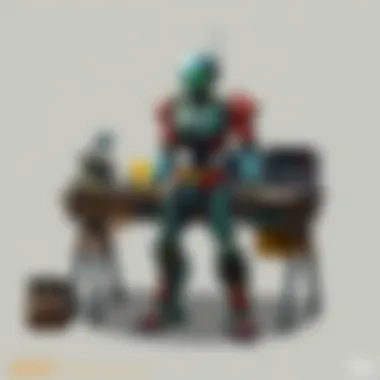
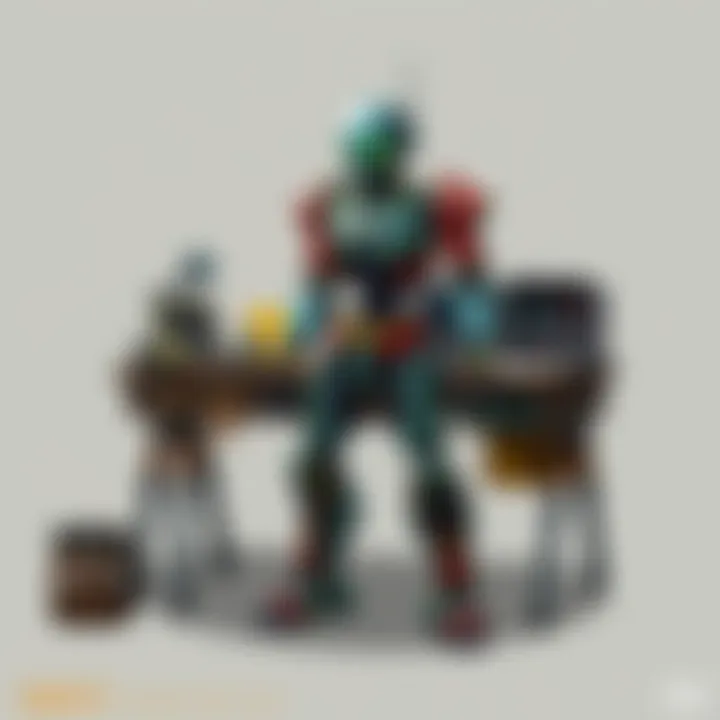
Importance in Gameplay
- Tactical Advantage: Deploying combat drones can provide significant advantages during engagements. Their firing capabilities can distract enemies, allowing players to maneuver and strategize without heavy fire.
- Durability Issues: Despite their strength, combat drones undergo severe wear and tear in battle. Damage types include physical hits from bullets, explosive bursts, and electrical overload due to combat conditions. Recognizing these vulnerabilities is essential for maintaining their effectiveness.
- Continual Upgrade: Players can enhance these drones with various upgrades, from better targeting systems to increased armor resilience. Knowing how to perform repairs correctly can be the difference between victory and defeat.
Service Robots
Service robots, such as the Protectron or Mr. Handy, provide valuable assistance in day-to-day operations, serving functions ranging from maintenance to companionship. Their designed specifications often make them more versatile in non-combat scenarios, allowing players to engage with them in different capacities beyond mere fight scenes.
Role and Benefits
- Multifunctionality: The service robot's ability to adapt to various tasks, from menial chores to assisting in combat, allows players to employ them flexibly.
- Resourcefulness: Many of these machines can assist with scavenging and crafting by locating needed materials. Keeping them fully operational ensures they can perform these functions effectively.
- Human-Robot Interaction: Engaging with service robots provides an insight into the game's narrative, enhancing players' immersion and understanding of the world. Their quirky dialogues and unexpected personality traits make the game feel alive.
Utility Robots
Utility robots are tailored for very specific and practical usages, such as the Assaultron or the Nuka-Cola Quantum Vending Machine. They are crucial for maintaining the survival aspects of gameplay, often providing crucial resources or support functionality.
Importance of Utility Robots
- Core Functions: Utility robots often provide access to unique resources, like crafting stations and items that are essential for survival. Understanding what each robot offers can greatly affect your resource management strategy.
- Upkeep is Key: Players must consistently monitor their health and function. Damage can stem from environmental hazards, combat, or general degradation from time in the wasteland.
- Part of the Ecosystem: These robots form an ecosystem where players must balance their use and ensure they possess the required tools to repair and maintain them.
In summary, the types of robots in Fallout underscore a distinct blend of narrative depth and gameplay strategy. Recognizing their roles and importance allows players to navigate the post-apocalyptic landscape with more precision and understanding, elevating their overall gaming experience.
“In the world of Fallout, a well-maintained robot is a player's best ally.”
For further reading on the lore of robotics in gaming, one might visit Wikipedia or explore community discussions on Reddit.
Understanding Robot Damage and Repair Mechanisms
In the vast landscapes of the Fallout series, robot repair transcends mere gameplay mechanics. It's ingrained in the very identity of the universe, where tech and survival intertwine. By understanding robot damage and the varied repair mechanisms, players not only enhance their experience but also contribute to their chances of thriving in an unforgiving world. Damage is not just a hindrance; it's an opportunity to engage deeper with the familiar yet complex systems that the game offers.
Types of Damage
Understanding the various types of damage robots can sustain is crucialfor any player hoping to keep their metal companions operational. Damage affects functionality and can lead to dire consequences if not dealt with effectively.
Physical Damage
Physical damage looms large in the Fallout universe, bringing tangible challenges to robot maintenance. This kind of damage arises when robots face direct attacks, be it from hostile factions or environmental hazards. It manifests as dents, broken limbs, or even severed parts. A key characteristic of physical damage is its visibility; players can often tell that a repair is needed just by glancing at the robot. This immediacy makes addressing physical issues an engaging part of gameplay.
The unique feature of physical damage lies in how it can impede a robot’s operational capabilities, such as movement or combat efficiency. In Fallout, a robot with a missing arm might struggle to wield a weapon or defend against foes effectively. The trade-off, however, is that these repairs often require simpler tools and parts to fix, which are more plentiful in the game world. Thus, focusing on physical damage can lead to quicker turnarounds in robot functionality, enhancing survivability.
Electrical Malfunctions
Electrical malfunctions introduce a different flavor of challenges in robot repair. This issue emerges when the intricate circuitry inside robots is compromised due to combat wear or old age. The telltale signs can range from erratic behavior to outright shutdowns. A crucial characteristic of electrical damage is its unpredictability; briefly rescuing a robot may lead to it glitching or acting autonomously.
These malfunctions also emphasize the importance of diagnostics in the repair process, pushing players to employ tools for detailed inspections. The unique aspect here is that electrical malfunctions often require more advanced tools or knowledge, which can be engaging for those players who relish tinkering with tech. However, the downside is the higher risk of failure in repairs, possibly sidelining a valuable ally longer than desired.
Software Corruption
Software corruption adds a layer of complexity that can be just as insidious as physical damage. As robots interact with their environment and other systems, errors in their programming may arise, affecting their responses and decision-making processes. One key characteristic of software corruption is that it isn’t always apparent until a robot fails in the field or exhibits erratic behavior.
This type of damage showcases the depth of storytelling in the Fallout series. It highlights that even machines created for utility can succumb to the chaos of their surroundings. Addressing software corruption often requires specific codes or programming repairs. While the outcomes can lead to improved functionality, the repairs often necessitate a broader knowledge base of the robot’s coding environment, making it a thrilling challenge for tech-savvy players.
Basic Repair Techniques
Getting your hands dirty with repairs involves understanding a few basic techniques that players can master with practice. This section is all about using the right tools and knowledge to fix robots efficiently. Common methods include:
- Analyzing damage types to determine appropriate fixes
- Utilizing specific tools designed for different aspects of repair
- Sourcing compatible parts from scavenged materials to make repairs possible
Familiarity with these techniques empowers players, turning each repair into a strategic element of their gameplay. Players who invest time into honing these skills not only develop invaluable allies but also enrich the narrative experience of surviving in a world shaped by decay and resilience.
"In the desolate expanse of the Wasteland, every repaired robot is a reminder that remnants of the past can be repurposed for future survival."
Tools Required for Robot Repair
In the realm of the Fallout universe, machinery reigns supreme amid the remnants of civilization. Understanding the tools necessary for robot repair is essential for players looking to enhance their gameplay experience. Proper tools can mean the difference between a fully operational companion and a pile of scrap metal. In this section, we will explore common and advanced repair tools that are indispensable for bringing robots back to life in the post-apocalyptic wasteland.
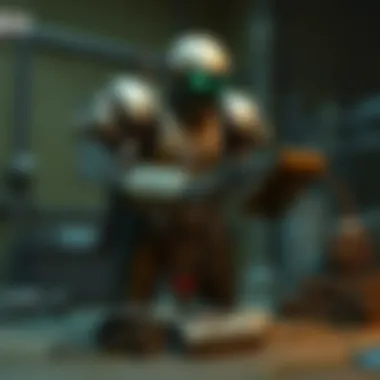
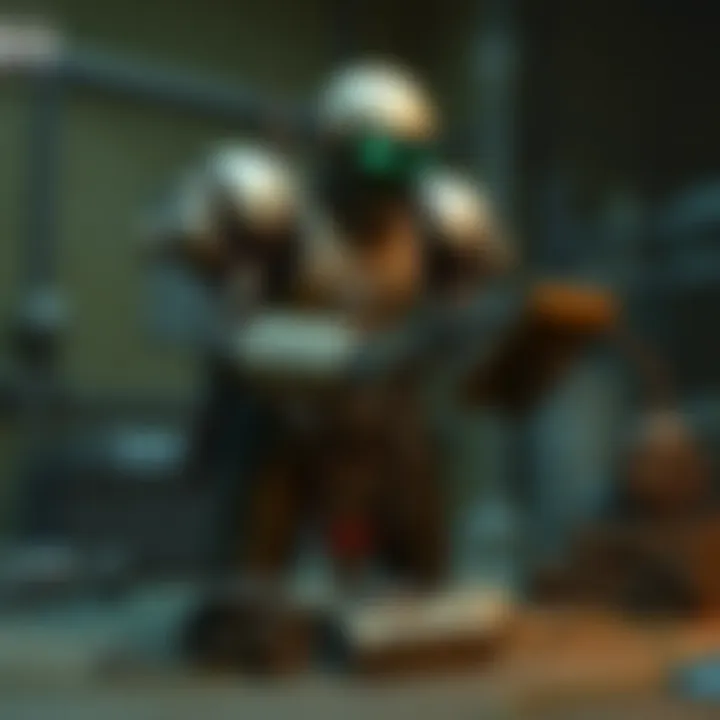
Common Repair Tools
Screwdrivers and Wrenches
Screwdrivers and wrenches are the bread and butter of any repair toolkit. These tools enable players to disassemble and reassemble the multitude of parts that make up robots. The versatility of screwdrivers allows repairmen to manage various types of screws—Phillips, flat-head, or even some more unusual models, typical in this universe.
Wrenches solve the threaded challenges they might face. Their ability to grip nuts and bolts provides the leverage needed to access inner workings that are often hidden from sight. One of the standout features of these tools is how simple they are to use, making them accessible for both seasoned repair aficionados and newcomers alike. However, one must be careful; it’s easy to strip a screw head if not applied correctly.
Diagnostic Tools
For effective robot repair, diagnostic tools become vital allies. These tools help identify underlying issues that might not be visible with the naked eye. Whether assessing a malfunction in circuitry or detecting software corruption, having these tools at hand is like having a scavenger's intel on a monster's weakness.
The primary characteristic of diagnostic tools is their ability to interface with a robot’s systems. Scanners can read error codes and suggest fixes. Some advanced models may even link up with a holo-tape for deeper analysis. This versatility makes diagnostic tools a compelling choice for any player wanting to get serious about repairing robots in the Fallout universe. Though, these tools can be relatively hard to come by, often requiring a bit of luck or trading with the right characters.
Replacement Parts
No repair job is complete without replacement parts. Whether it’s an electronic component or a mechanical limb, having the correct parts on hand ensures that robots can be restored to their former glory—or better. Replacement parts are crucial for handling different types of damage, be they physical or electrical.
A key feature is the range of compatibility. Many parts can be interchangeable between different models, which offers an economy of scale when searching for components. However, the downside could be the scarcity of some specific parts, which may drive players to explore more dangerous territories or meticulously comb through debris for that one elusive piece.
Advanced Tools
When basic tools simply don't cut it, advanced ones become a major asset. Specialized equipment aimed at sophisticated repairs can lead to increased success rates and unlock potential upgrades for robots.
Advanced tools come into play when repairs require precision, like adjusting sensitive sensors or recalibrating AI modules. Tools such as soldering kits and orbital sanders allow for focused repairs that standard tools can't handle. They can make a massive difference in how a robot responds in the field; players armed with such tools can often turn the tide during tougher encounters in the wasteland.
In summary, an understanding and mastery of these tools can significantly influence a player’s experience in Fallout. Not only do they facilitate effective repairs, enhancing the capabilities of robotic companions, but they also add layers of strategy and decision-making to gameplay. Engaging with this aspect of the game can open new doors for exploration and combat effectiveness, making efficient robot repair not just a task, but an adventure in itself.
Repairing Companion Robots
Repairing companion robots is a crucial aspect of navigating the unforgiving landscape in the Fallout universe. These mechanical allies not only add depth to gameplay but are also essential in various missions and combat scenarios. The closer one gets to understanding and maintaining these robots, the better prepared they will be for the challenges that arise in the wasteland. The intricacies involved in robot repair can often determine the difference between success and failure in critical moments, making this knowledge invaluable for both veteran players and newcomers alike.
Identifying Issues
Before embarking on the repair journey, one must first pinpoint what’s gone awry with the companion robot. It's as if you're a detective, searching for clues to uncover the underlying problems. Here are several key indicators and common issues to look out for:
- Performance Drops: Does your trusty bot seem to lag? Performance drops can be indicative of hardware issues or simple wear and tear due to battle.
- Error Messages: Pay close attention to any error notifications that may pop up. These often provide direct insight into what’s malfunctioning.
- Unusual Behavior: If the robot starts acting erratically—like refusing to follow commands or engaging in unintended combat—there’s probably something off beneath its metal shell.
- Physical Damage: Visible dents, scratches, or missing parts can often point toward the need for immediate repair, especially after a tough skirmish.
Identifying these issues can save a player both time and resources when it comes down to repairs. It’s like diagnosing a sickness; the sooner you figure out what’s wrong, the quicker you can treat it—allowing your companion to return to full fighting form.
Tips for Effective Repairs
With the issues identified, it’s time to get your hands dirty. Repairing robots requries specific techniques and attention to detail. Here are some essential tips to ensure effective repairs:
- Have the Right Tools: You wouldn’t attempt to fix a car with just a butter knife, right? Gather the right tools such as screwdrivers, wrenches, and diagnostic gadgets. The right equipment makes all the difference.
- Follow the Manual: Many robots come with instruction manuals that outline their repair protocols. Although reading manuals isn’t always the most thrilling activity, it often pays off with clear, actionable steps.
- Check Battery Health: Sometimes it’s as simple as a drained battery. Regularly check power cells and replace them where needed. No juice means no action.
- Upgrade Components: If your robot is older, its parts could also be outdated. Look out for upgraded components or patches that enhance functionality while maintaining compatibility.
- Test After Repair: Once you’ve done the repairs, evaluate your work. Run diagnostics and take your robot for a spin to see if it’s back on its feet. Better safe than sorry, as they say.
"In the wasteland, every bolt and screw counts. Being meticulous can ensure your survival and that of your mechanical ally."
In the end, repairing companion robots isn’t just about fixing a tool; it’s about ensuring a reliable partnership. The better equipped you are in these repairs, the richer your gameplay experience will become. Not only can you maximize the potential of these robots, but player-robot synergy often leads to more strategic maneuvers in combat and exploration.
The Significance of Robot Repair in Gameplay
In the chaotic landscape of the Fallout universe, where uncertainty is the norm, effective robot repair transforms gameplay from a monotonous grind into a dynamic strategy. Robots in this post-apocalyptic realm play pivotal roles, enhancing the player's capabilities, resources, and overall experience. As such, mastering the mechanics of robot repair is not merely an ancillary skill; it's integral to surviving the harsh conditions of the wasteland.
Enhancing Combat Effectiveness
Robotic companions can significantly tip the scales during combat. Having a battle-ready robot alongside you means additional firepower, not to mention the ability to absorb damage that would otherwise target the player.
Imagine walking into a raider camp with a repaired and upgraded Assaultron. With its agility and lethal weaponry, it can turn the tide in a split-second. Here are some benefits of keeping your combat robots in top shape:
- Increased Damage Output: Robots like the Sentry Bot can deal considerable damage, provided they are functioning correctly.
- Enhanced Durability: Repairing robots boosts their hit points, meaning they can withstand more punishment during skirmishes.
- Upgrades: Beyond basic repairs, you can install mods that improve accuracy, reload speed, and even defensive capabilities.
This approach not only enhances your effectiveness in fights but also allows for deeper strategic planning. Personalizing robots for specific combat roles can create a versatile team suited for tackling various threats throughout the wasteland.
Resource Management
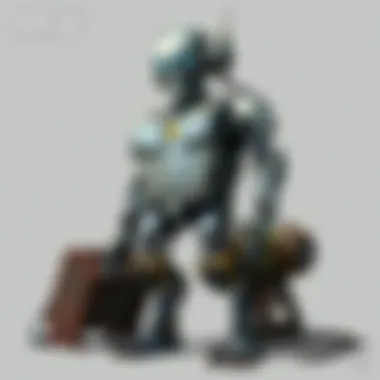
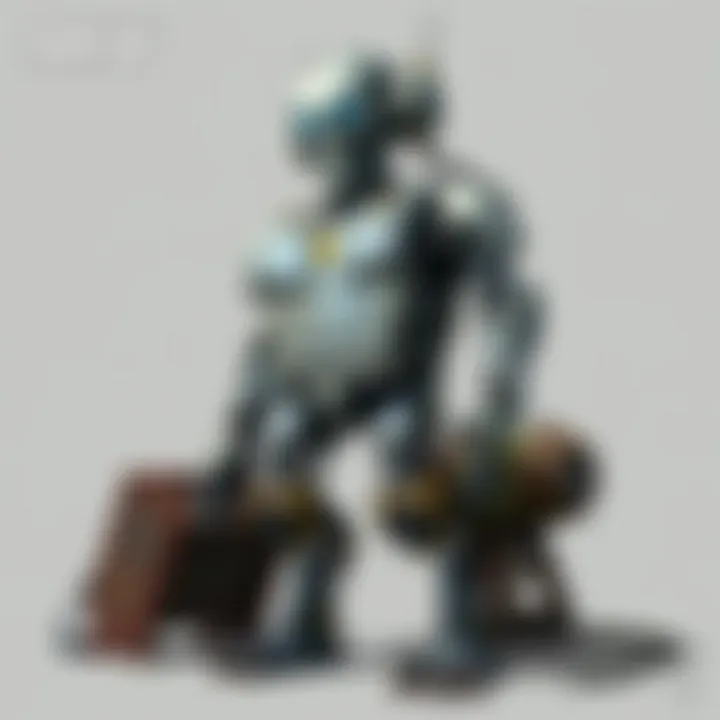
In addition to combat prowess, robot repair plays a crucial role in resource management. In Fallout, resources tend to dwindle, and every scrap of materials counts. Understanding how to repair robots not only extends their lifespan but can also lead to significant saving in broader terms.
Consider these factors:
- Material Efficiency: Repairing robots often requires local resources that can be scavenged easily. This mitigates the need to expend rare materials on more complex weaponry or armor repairs.
- Maintenance Costs: Instead of continually replacing lost companions, you can improve existing ones. This reduces the overall cost of having an army at your command.
- Leveraging Companion Skills: Some robots come equipped with unique skills that can gather resources or provide extra inventory space. By ensuring these companions are well-maintained, you can maximize their potential in resource collection, ultimately balancing your survival strategy.
"In the wasteland, a well-maintained robot is worth its weight in caps. Repair strategically, and you'll find survival becomes that much easier."
The interplay between robot repair and gameplay mechanics renders it a core activity worth mastering. Not only does it lead to better outcomes in combat, but it also fosters smarter resource management strategies that are critical for players navigating the challenges of the Fallout universe.
Lore and Backstory of Iconic Robots
The lore surrounding robotic characters in the Fallout universe is not merely an embellishment; it serves as the very foundation that enriches the narrative and gameplay. Examining the backstory and cultural significance of these machines offers players a deeper engagement with the game. Robots in Fallout are more than tools; they reflect humanity's hopes, fears, and follies in the face of technological advancement. Through their complex backgrounds, players gain insights into pre-war society, the ethical dilemmas associated with artificial intelligence, and the ongoing struggle for survival in a world turned to chaos.
Famous Robots in Fallout
Throughout the series, several robots stand out as icons, each with its distinct backstory that strengthens their role in the narrative:
- Codsworth: Serving as the ever-loyal butler pre-apocalypse, Codsworth's continued existence forces players to confront themes of loyalty and loss. His character evolution showcases the lingering vestiges of human emotions embedded within technology.
- Mr. Handy: This multi-purpose robot not only assists with chores but also nods to the 1950s ideal of domestic life. Mr. Handy robots, with their charming yet eerie demeanor, embody an era that was, ironically, unaware of the dark future ahead.
- Protectrons: As simple security robots, they reveal the cautionary tales of relying heavily on automated systems. Encountering Protectrons evokes a sense of nostalgia and trepidation, illustrating how technology can be both a protector and a menace.
The backstories of these robots weave a rich tapestry of human experience and societal commentary, making them unforgettable characters in the wasteland.
Cultural Impact of Robots
The influence of robots within the Fallout franchise stretches beyond the confines of the game itself. They have sparked discussions around ethical questions in AI development.
- Reflection of Society's Fears: The narrative positions robots as a mirror reflecting anxieties about technology usurping human agency. Players often find themselves questioning the ramifications of what it means to create life-like machines.
- Pop Culture Redistributions: Robots like Codsworth and Mr. Handy have transcended the game, appearing in merchandise such as action figures, fandom art, and memes. This cross-media presence underscores how deeply entrenched these characters have become in the cultural consciousness of both players and non-players alike.
- Exploration of Identity: The journey of these robotic characters prompts players to contemplate identity, consciousness, and what it means to be 'alive'. This philosophical dimension elevates the gaming experience, providing depth that resonates on multiple levels.
In summary, the lore and narratives intertwined with robots in Fallout offer players a more immersive experience. They provide context to the harsh realities of a post-apocalyptic world while shining a light on broader social issues that resonate even outside of gaming. Understanding these aspects not only enhances gameplay but compels players to reflect on the consequences of robotics in their realities.
The Future of Robot Technology in Fallout
The future of robot technology within the Fallout universe is not just a look ahead; it is a contemplation of what unfolds as the narrative progresses. This compelling topic not only ties together existing lore but hints at the possibilities that players can expect in upcoming games. With each iteration of the series, developers breathe new life into the robotic landscape, enabling players to interact with these machines in more profound ways. Understanding this future involves examining the advancements that reshape gameplay mechanics, the lore behind these advancements, and how they reflect broader themes pertinent to a post-apocalyptic world.
Upcoming Games and Applications
The anticipation surrounding future Fallout games stirs the imagination. Developers like Bethesda often tease fans with hints of innovations. The upcoming titles may unleash a whirlwind of new robotic technologies, enriching the gameplay experience. Players might expect:
- Enhanced AI Systems: Future robots may feature smarter functionalities, adapting to combat scenarios. Imagine a Mr. Handy able to not only assist in combat but also strategize based on real-time events, providing tactical advantages.
- Customization Options: There could be more avenues for personalizing robot companions. Crafting parts with unique abilities or looks can deepen engagement. Players may find themselves sinking time into designing a robot that better reflects their playstyle.
- Integration with the Environment: Better interactions with the environment around them might be on the horizon. A robot that can scan surroundings for items or hidden resources could make scavenging more efficient, impacting exploration and resource management.
Closer collaboration between the community and developers through platforms like reddit.com may also spark new ideas and applications. This symbiosis could lead to a future where fan feedback directly influences the robot technology seen in new releases.
Fan Theories and Speculations
As with many lore-rich universes, speculation runs rampant among fans looking to piece together what lies ahead for robot technology in Fallout. These theories often revolve around hinted features or developments mentioned in previous games and their tying to current socio-technical discussions:
- Rebuilding Civilization: Some fans speculate that the future of robots might involve a more active role in rebuilding society. Could we see robots transitioning from combat to supportive roles in establishing settlement infrastructure? This notion touches on deeper themes of cooperation and coexistence, mirroring real-world technology debates.
- Ethical Dilemmas: Players often ponder how future narratives will address the morality of sentient robots. The question remains: if a robot has the capability to learn and adapt, does it deserve the same rights as humans? This angle invites players to engage not only in gameplay but ethical discussions that resonate in today's society.
- Crossover with Other Universes: The possible merging of ideas with other franchises has excited fans. Will we see inspirations pulled from other post-apocalyptic games, such as Metro Exodus or The Last of Us, integrating advanced robot mechanics into the Fallout world?
As these theories swirl through the community, it is crystal clear that the future of robot technology is a hotbed of creativity and speculation. By engaging thoughtfully with these topics, fans can cultivate a deeper understanding of the evolving role robots will play, both in gameplay mechanics and the overarching narrative.
"The evolution of robot technology in Fallout isn’t just about wires and circuits; it’s about the stories they tell and the futures they build."
In summary, as we peer into the future of robot technology in Fallout, we find a realm ripe with potential. The way forward involves not just advancements in mechanics and gameplay, but also a rich narrative foundation that compels players to reflect on societal implications, redefine ethics in a technological world, and embrace the creative potential of fan contributions.
For more insights into the lore and upcoming features, consider exploring en.wikipedia.org or joining the discussions on platforms like facebook.com or reddit.com.
The End
In any exploration of the Fallout universe, the theme of robot repair stands out as not merely a gaming mechanic, but as an essential narrative component that enriches the player's journey. This article has delved into the multifaceted aspects surrounding robot repair, illuminating the various types of robots and their roles, the intricate repair mechanisms, and the tools necessary for effective maintenance.
The importance of robot repair in Fallout can be distilled down to several key elements:
- Survival in a Harsh Environment: The wastelands are unforgiving, and having functional robotic companions can mean the difference between life and death. Keeping robots repaired ensures they can fight alongside the player or assist in resource collection.
- Engagement with Lore: Repairing robots isn’t just a technical challenge; it often ties back to the rich narratives present in the game. Understanding a robot’s backstory can impact gameplay and player choices significantly.
- Strategic Planning: Players who take the time to master the repair system can optimize their resources. Efficient repairs can free up items for more critical needs while enhancing team dynamics in combat scenarios.
- Player Agency: The ability to repair and maintain robots adds layers of engagement. It allows players to shape their gameplay experience actively, tailoring their skills to meet the challenges ahead.
Summarizing Key Takeaways
- Diversity of Robots: Players encounter various robot types, each requiring specific repairs and maintenance strategies, emphasizing the need for comprehensive knowledge.
- Complexity of Repairs: Repairing robots involves recognizing different types of damage, employing various repair techniques, and utilizing specific tools. Ensuring a well-rounded understanding leads to more efficient gameplay.
- Gameplay Impact: Successful repairs elevate gameplay by enhancing combat effectiveness and enabling resource management, inviting greater exploration and strategic choices.
The Continuing Relevance of Robots in Gaming
Robots in gaming, particularly within the Fallout universe, serve several continued purposes:
- Narrative Depth: The complexities of AI and robotics provide rich storytelling opportunities, challenging players to consider ethics, ownership, and personality beyond simple combat mechanics.
- Player Experience: Engaging with robot repair dynamically alters a player's experience. This not only creates investment in the gameplay but also invites community discourse around strategy and combat optimization.
- Emerging Technologies: As new games continue to explore the possibilities of AI and robotics, Fallout’s interpretation remains relevant. Fans often speculate about future technologies within the franchise, influencing both gameplay direction and narrative possibilities.
"In essence, the world of robot repair in the Fallout universe holds meaning beyond maintenance; it’s a bridge connecting story and gameplay, emphasizing the enduring role of technology in our lives."







